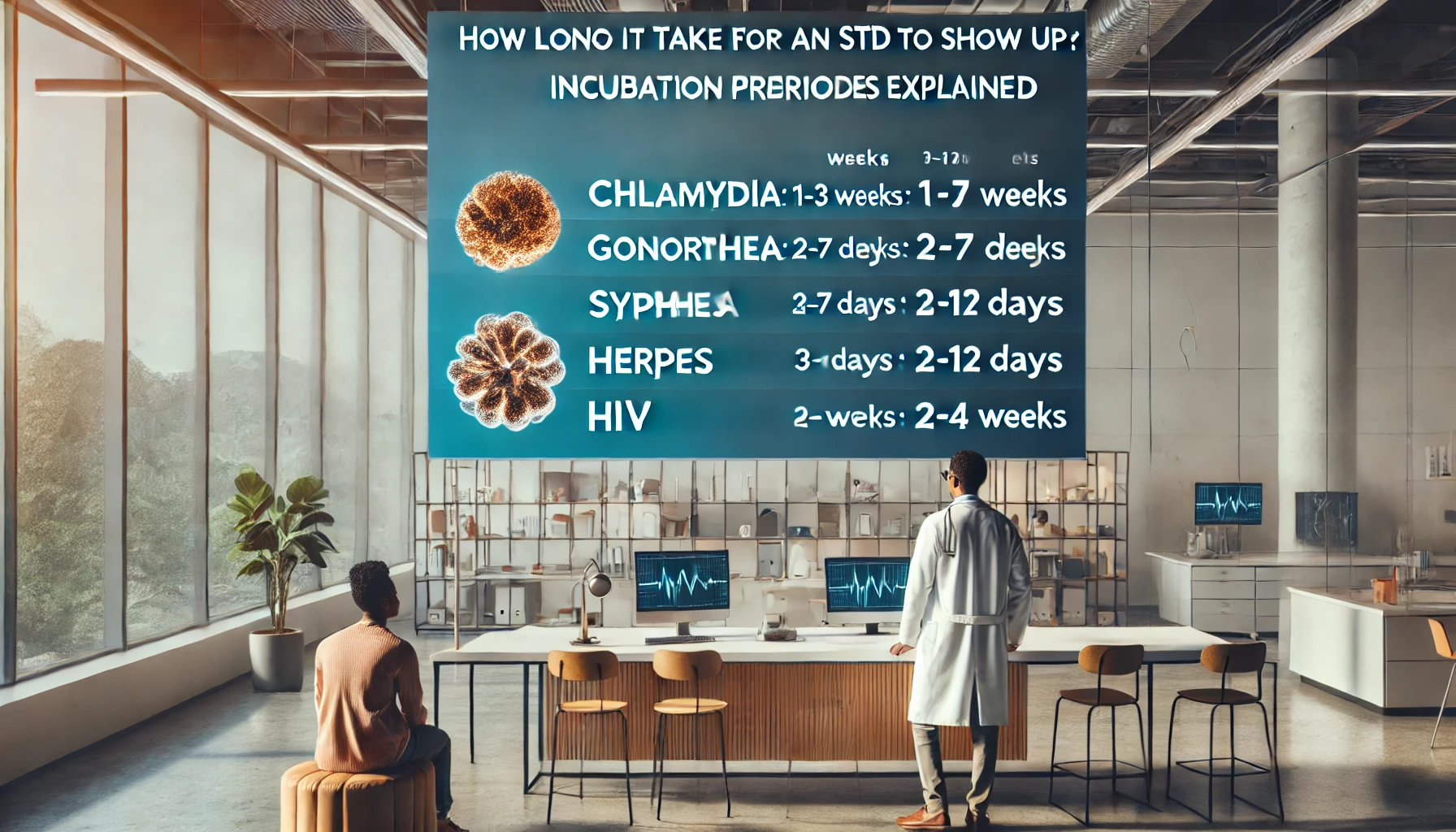When someone is exposed to a sexually transmitted disease (STD), they often wonder, “How long before symptoms appear?” The incubation period—the time between exposure and the first symptoms—varies depending on the type of infection. Some STDs show symptoms within days, while others may take weeks, months, or even years to appear.
Understanding STD incubation periods is essential for early detection, timely testing, and treatment to prevent further complications and transmission.
Why Do Incubation Periods Matter?
✔️ Helps determine the right time to get tested after exposure.
✔️ Prevents false-negative test results if tested too early.
✔️ Avoids unknowingly spreading an infection to others.
✔️ Guides early treatment and prevention of complications.
✔️ Reduces the risk of long-term damage from untreated STDs, such as infertility, chronic pain, and increased HIV risk.
💡 Some STDs have NO symptoms for months or years, which is why routine testing is crucial.
Common STD Incubation Periods
Each STD has its own timeline for incubation. The table below provides an overview of how long it typically takes for an infection to become detectable.
| STD | Incubation Period | When to Get Tested |
|---|---|---|
| Chlamydia | 1 to 3 weeks | 1-3 weeks after exposure |
| Gonorrhea | 2 to 7 days | 1-2 weeks after exposure |
| Syphilis | 3 weeks to 3 months | 3-6 weeks after exposure |
| Herpes (HSV-1 & HSV-2) | 2 to 12 days | Test when symptoms appear |
| HIV | 2 to 4 weeks | 2-4 weeks after exposure (early detection tests available) |
| HPV (Genital Warts) | 1 month to years | Test when warts appear |
| Trichomoniasis | 5 to 28 days | 1-4 weeks after exposure |
| Hepatitis B & C | 2 weeks to 6 months | 6 weeks to 6 months after exposure |
| Mycoplasma Genitalium | 1 to 3 weeks | 2-3 weeks after exposure |
| Pubic Lice (‘Crabs’) | 5 days to 3 weeks | Check when symptoms appear |
| Scabies | 4 to 6 weeks | Test when symptoms appear |
💡 Some infections remain dormant for years before causing health problems, which is why regular testing is critical.
How Soon Should You Get Tested After Exposure?
Getting tested too early can result in false negatives because the infection hasn’t fully developed. Follow these guidelines:
✔️ If you suspect exposure: Get tested 1-2 weeks after, then again after 3 months to confirm.
✔️ If you have symptoms: Get tested immediately.
✔️ For routine checkups: If sexually active, test every 3-6 months.
✔️ If a partner tests positive: Get tested right away, even if you have no symptoms.
✔️ For high-risk individuals: (multiple partners, unprotected sex, history of STDs), frequent testing is recommended.
What If an STD Has No Symptoms?
🚨 Silent infections are common! Many STDs, like chlamydia, gonorrhea, HPV, and HIV, can stay dormant without symptoms but still be contagious.
✔️ Regular testing is the only way to know for sure. ✔️ Untreated STDs can cause serious health issues, including infertility, organ damage, and increased HIV risk. ✔️ Always inform partners if you test positive, even if you have no symptoms. ✔️ HPV and herpes can be transmitted even when there are no visible symptoms. ✔️ Some STDs can lead to severe complications such as pelvic inflammatory disease (PID), cancer, and neurological disorders.
What Happens If You Ignore an STD?
Many STDs get worse over time if left untreated. Possible long-term effects include:
🚨 Chlamydia & Gonorrhea – Can lead to infertility, pelvic inflammatory disease (PID), and chronic pelvic pain.
🚨 Syphilis – If untreated, can cause blindness, heart disease, and neurological problems.
🚨 HIV – Weakens the immune system, making the body vulnerable to life-threatening infections.
🚨 HPV – Certain strains can cause cervical, anal, and throat cancers.
🚨 Herpes – Lifelong condition with recurring painful outbreaks.
🚨 Hepatitis B & C – Can lead to liver damage, cirrhosis, and cancer.
💡 Early detection saves lives. Always prioritize STD screenings if you’re sexually active.
Best Ways to Prevent STD Transmission
✔️ Use condoms & dental dams every time.
✔️ Get vaccinated for HPV and Hepatitis B.
✔️ Get tested regularly – at least once a year, or every 3-6 months if at higher risk.
✔️ Limit multiple partners to reduce exposure.
✔️ Communicate openly about STD history with partners.
✔️ Consider PrEP for HIV prevention if at risk.
✔️ Use licensed tattoo and piercing shops to prevent needle-related infections.
✔️ Avoid sharing personal items like razors or toothbrushes that may contain blood or fluids.
Final Thoughts
The incubation period for STDs varies, making timing crucial for accurate testing. If you suspect exposure, don’t panic—just follow the right timeline for testing. Regular screenings help detect infections early and protect your sexual health!
💙 Stay informed, get tested, and take control of your health!
References
- Centers for Disease Control and Prevention (CDC). “STD Testing Guidelines.” www.cdc.gov/std
- Mayo Clinic. “How Long Does It Take for an STD to Show Up?” www.mayoclinic.org
- Planned Parenthood. “How Soon Can I Get Tested for STDs?” www.plannedparenthood.org

Leave a Reply